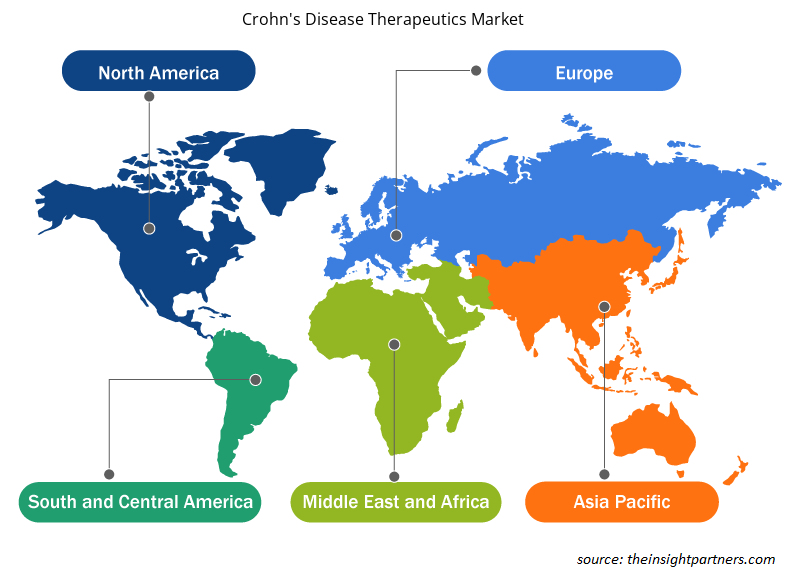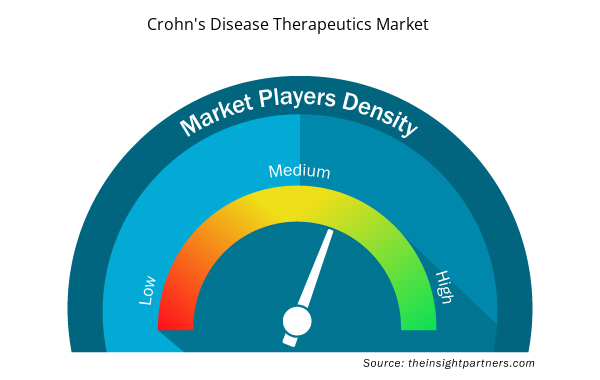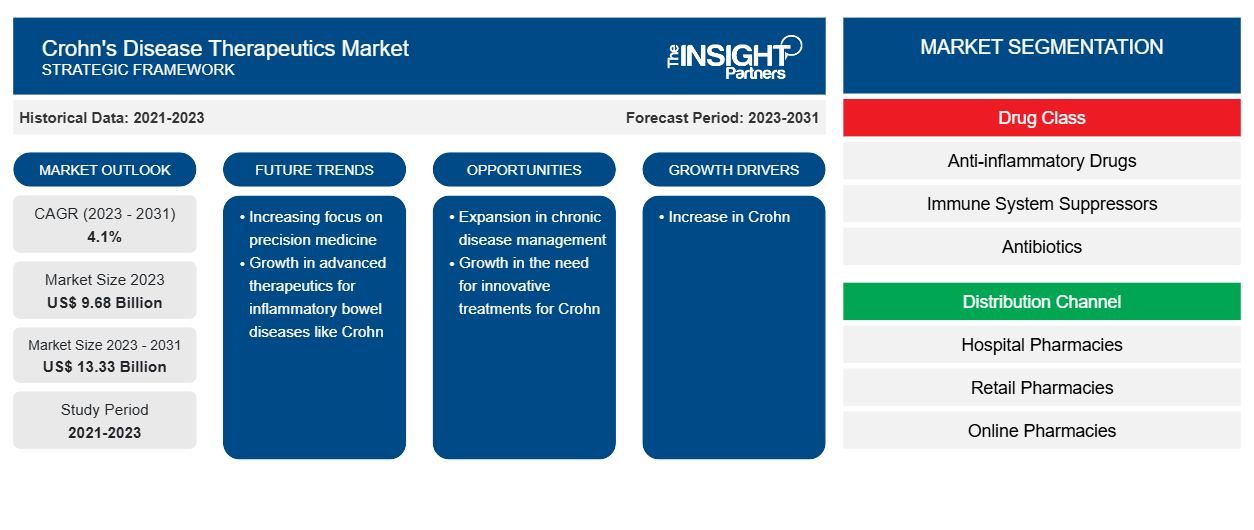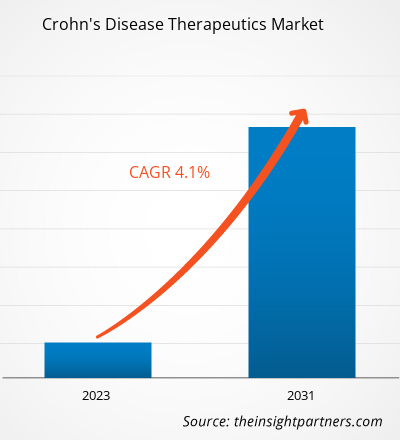[調査レポート] クローン病治療薬市場は2023年に96億8,000万米ドルと評価され、2031年までに133億3,000万米ドルに達すると予測されています。2023年から2031年にかけて4.1%のCAGRを記録すると予想されています。
市場洞察とアナリストの見解:
クローン病は、主に消化管に影響を及ぼす慢性炎症性疾患です。一般的には、小腸の末端と大腸の始まりに発症します。この疾患は消化管の内壁の炎症を特徴とし、腹痛、下痢、栄養失調などの症状を引き起こします。クローン病治療薬市場規模の拡大は、欧米諸国、特に米国における疾患の罹患率の増加に起因しています。さらに、市場で競争力を維持するための企業による戦略的取り組みが市場の成長を後押ししています。高度な医療機器の使用が大幅に増加することで、予測期間中にクローン病治療薬市場に新たなトレンドがもたらされる可能性があります。
成長の原動力と課題:
クローン病は過敏性腸症候群の一種で、特異的な治療法のない慢性の炎症性腸疾患です。この疾患の正確な病因は不明ですが、この疾患は主に、薬物、毒素、感染症、腸内細菌、その他の環境要因に対する腸内の不適切な免疫反応の結果であり、特に遺伝的に感受性の高い宿主で多く見られます。国立医学図書館によると、クローン病 (CD) は西側先進国、特に北米、北ヨーロッパ諸国、ニュージーランドでより一般的です。この疾患の発症は 15~30 歳と 40~60 歳の個人に最も多く見られ、都市部でより顕著です。この疾患の発生率は北ヨーロッパ諸国とユダヤ系の人々で高く、1,000 人あたり 3.2 人です。しかし、最近の研究では、アジア、アフリカ、オーストラレーシアでも、この地域の急速な工業化により発生率が大幅に増加していることが示されています。したがって、それぞれの地域におけるクローン病の驚くべき蔓延は、クローン病治療薬市場を押し上げます。
国立衛生研究所によると、クローン病はヨーロッパで患者 1 人あたり年間約 3,500 米ドルの直接医療費がかかるなど、大きな経済的負担となっています。この病気は 10 万人あたり約 322 人が罹患しています。ただし、罹患率は国によって異なります。クローン病患者の 50% 以上は正式に診断されていないか、他の消化管疾患と同じ症状を示すことがあります。クローン病は男性よりも女性に多く見られ、女性の罹患率は男性の 3 倍にもなります。
過敏性腸症候群の医薬品開発に携わる企業は、症状、診断、治療に関する認識を広めることでこの症候群に効果的に対処することを目的とした啓発プログラムを実施するための建設的な措置を講じています。2018年、アラガン社とアイアンウッド社は共同で、患者が消化管障害について学び、対策を講じるよう促すインタラクティブ デジタル デスティネーション プラットフォームを立ち上げました。このように、過敏性腸症候群の有病率の上昇は、クローン病治療薬市場の成長を促進しています。
要件に合わせてレポートをカスタマイズする
このレポートの一部、国レベルの分析、Excelデータパックなど、あらゆるレポートを無料でカスタマイズできます。また、スタートアップや大学向けのお得なオファーや割引もご利用いただけます。
- このレポートの主要な市場動向を入手してください。この無料サンプルには、市場動向から見積もりや予測に至るまでのデータ分析が含まれます。
レポートのセグメンテーションと範囲:
クローン病治療薬市場の分析は、薬剤の種類、流通チャネル、および地域という以下のセグメントを考慮して実施されました。薬剤クラス別に見ると、市場は抗炎症薬、免疫系抑制剤、抗生物質、生物製剤、下痢止め、鎮痛剤に分類されています。生物製剤セグメントは2023年に最大の市場シェアを占めました。抗炎症薬セグメントは、2023年から2031年の間に最高のCAGRを記録すると予想されています。
エンドユーザーに基づいて、市場は病院薬局、臨床薬局、およびオンラインその他に分かれています。病院薬局セグメントは、2023年にクローン病治療薬市場で最大のシェアを占めました。地理的には、クローン病治療薬市場レポートの範囲には、北米(米国、カナダ、メキシコ)、ヨーロッパ(スペイン、英国、ドイツ、フランス、イタリア、その他のヨーロッパ)、アジア太平洋(韓国、中国、日本、インド、オーストラリア、その他のアジア太平洋)、中東およびアフリカ(南アフリカ、サウジアラビア、UAE、その他の中東およびアフリカ)、南米および中米(ブラジル、アルゼンチン、その他の南米および中米)が含まれます。
地域分析:
北米は、世界のクローン病治療薬市場の成長に最も大きく貢献しています。アジア太平洋地域は、2023年から2031年にかけて市場で最も高いCAGRを記録すると予測されています。北米の市場発展は、慢性疾患の発生率の増加、技術の進歩と技術的に高度な医療製品へのアクセス、高齢者人口の急増、新製品および既存製品の開発に携わる主要な市場プレーヤーの存在に起因しています。米国は、2023年に北米で最大のクローン病治療薬市場シェアを占めました。
クローン病治療薬
クローン病治療薬市場の地域別分析
予測期間を通じてクローン病治療薬市場に影響を与える地域的な傾向と要因は、Insight Partners のアナリストによって徹底的に説明されています。このセクションでは、北米、ヨーロッパ、アジア太平洋、中東、アフリカ、南米、中米にわたるクローン病治療薬市場のセグメントと地理についても説明します。

- クローン病治療薬市場の地域別データを入手
クローン病治療薬市場レポートの範囲
| レポート属性 | 詳細 |
|---|---|
| 2023年の市場規模 | 96億8千万米ドル |
| 2031年までの市場規模 | 133.3億米ドル |
| 世界のCAGR(2023年~2031年) | 4.1% |
| 履歴データ | 2021-2023 |
| 予測期間 | 2023-2031 |
| 対象セグメント | 薬物クラス別
|
| 対象地域と国 | 北米
|
| 市場リーダーと主要企業プロフィール |
|
クローン病治療薬市場のプレーヤー密度:ビジネスダイナミクスへの影響を理解する
クローン病治療薬市場は、消費者の嗜好の変化、技術の進歩、製品の利点に対する認識の高まりなどの要因により、エンドユーザーの需要が高まり、急速に成長しています。需要が高まるにつれて、企業は提供品を拡大し、消費者のニーズを満たすために革新し、新たなトレンドを活用し、市場の成長をさらに促進しています。
市場プレーヤー密度とは、特定の市場または業界内で活動している企業または会社の分布を指します。これは、特定の市場スペースに、その市場規模または総市場価値に対してどれだけの競合相手 (市場プレーヤー) が存在するかを示します。
クローン病治療薬市場で事業を展開している主要企業は次のとおりです。
- アッヴィ株式会社
- ジョンソン・アンド・ジョンソン・プライベート・リミテッド
- グラクソ・スミスクライン
- メルク株式会社
- ノバルティスAG
免責事項:上記の企業は、特定の順序でランク付けされていません。

- クローン病治療薬市場のトップキープレーヤーの概要を入手
業界の発展と将来の機会:
クローン病治療薬市場の予測は、主要な企業の出版物、協会データ、データベースなど、さまざまな二次および一次研究結果に基づいて推定されています。企業のプレスリリースによると、クローン病治療薬市場で活動している主要企業による主要な開発は次のとおりです。
- 2023年、米国食品医薬品局(FDA)は、中等度から重度のクローン病の治療薬として初の経口薬「リンヴォック(ウパダシチニブ)」を承認した。リンヴォックは、腫瘍壊死因子(TNF)を阻害する候補薬で治療が奏功しなかった成人患者の治療を目的としている。
- 2022年、FDAは中等度から重度の活動性クローン病の成人患者の治療薬としてスカイリージを承認した。
- 2021年、アッヴィ社はクローン病の治療薬リサンキズマブの第3相試験の開始を発表しました。リサンキズマブは、インターロイキン-23(IL-23)経路を選択的に標的とするヒト化モノクローナル抗体です。この試験は、中等度から重度のクローン病患者におけるリサンキズマブの有効性と安全性を評価することを目的としています。
- 武田薬品工業株式会社は2021年、クローン病の治療薬として経口化合物TAK-721の第3相試験を開始すると発表しました。TAK-721はケモカイン受容体CXCR3の選択的拮抗薬です。この試験は、中等度から重度のクローン病患者におけるTAK-721の有効性と安全性を評価することを目的としています。
競争環境と主要企業:
クローン病治療薬市場レポートで紹介されている主な企業には、Abbvie, Inc.、Johnson and Johnson Private Limited、GlaxoSmithKline Plc、Merck and Co., Inc.、Novartis Ag、Celgene Corporation、Genentech、Pfizer Inc.、Nestle Health Science、Boehringer Ingelheim GmbH などがあります。さらに、市場とそのエコシステムの全体像を把握するために、この調査では他の企業数社も調査および分析されています。これらの企業は、世界中の消費者からの高まる需要を満たすために地理的拡大と新製品の発売に注力し、専門ポートフォリオで製品範囲を拡大しています。グローバルなプレゼンスにより、大規模な顧客ベースに対応でき、その結果、市場拡大が促進されます。
- 過去2年間の分析、基準年、CAGRによる予測(7年間)
- PEST分析とSWOT分析
- 市場規模価値/数量 - 世界、地域、国
- 業界と競争環境
- Excel データセット


- Aircraft Landing Gear Market
- Grant Management Software Market
- Artificial Turf Market
- Bioremediation Technology and Services Market
- Genetic Testing Services Market
- Personality Assessment Solution Market
- Long Read Sequencing Market
- Ketogenic Diet Market
- Occupational Health Market
- Analog-to-Digital Converter Market

Report Coverage
Revenue forecast, Company Analysis, Industry landscape, Growth factors, and Trends

Segment Covered
This text is related
to segments covered.

Regional Scope
North America, Europe, Asia Pacific, Middle East & Africa, South & Central America

Country Scope
This text is related
to country scope.
よくある質問
The increasing burden of irritable bowel syndrome, and the increasing in number of FDA approval and drug development bolster the Crohn’s disease therapeutics market size. However, the high cost of the treatment hinders the Crohn’s disease therapeutics market growth.
Based on geography, the Crohn’s Disease Therapeutics Market is segmented into North America (the US, Canada, and Mexico), Europe (the UK, Germany, France, Italy, Spain, and the Rest of Europe), Asia Pacific (China, Japan, India, South Korea, Australia, and the Rest of Asia Pacific), the Middle East & Africa (the UAE, Saudi Arabia, South Africa, and Rest of the Middle East & Africa), and South & Central America (Brazil, Argentina, and the Rest of South & Central America). North America is the largest contributor to the growth of the global Crohn’s Disease Therapeutics Market. Asia Pacific is expected to register the highest CAGR in the Crohn’s Disease Therapeutics Market during 2023–2031.
The Crohn’s disease therapeutics market, based on drug class, is segmented into anti-inflammatory drugs, immune system suppressors, antibiotics, biologics, anti-diarrheal, and pain reliever. In 2023, the biologics segment held the largest Crohn’s disease therapeutics market share. The Crohn’s disease therapeutics market, by distribution channel, is segmented into hospital pharmacy, retail pharmacy, online pharmacy. In 2023, the hospital pharmacy segment held the largest Crohn’s disease therapeutics market share and is anticipated to record the highest CAGR during 2023–2031.
The Crohn’s Disease Therapeutics Market majorly consists of the players such Abbvie, Inc.; Johnson and Johnson Private Limited; GlaxoSmithKline Plc; Merck and Co., Inc.; Novartis Ag; Celgene Corporation; Genentech; Pfizer Inc.; Nestle Health Science; and Boehringer Ingelheim Gmbh
Crohn's disease is a chronic inflammatory condition that primarily affects the gastrointestinal tract. It commonly affects the end part of the small intestine and the beginning of the large intestine. The disease is characterized by the inflammation of the digestive tract lining, leading to symptoms such as abdominal pain, diarrhea, and malnutrition. The growing Crohn's disease therapeutics market size is attributed to the increasing prevalence of diseases in Western countries, particularly the US. In addition, strategic initiatives by companies to stay competitive in the market are fueling market growth. A significant increase in the use of medical devices is likely to bring new Crohn's disease therapeutics market trends during the forecast period.
Trends and growth analysis reports related to Life Sciences : READ MORE..
The List of Companies - Crohn's Disease Therapeutics Market
- ABBVIE, INC.
- JOHNSON AND JOHNSON PRIVATE LIMITED
- GLAXOSMITHKLINE PLC
- MERCK AND CO., INC.
- NOVARTIS AG
- CELGENE CORPORATION
- GENENTECH
- PFIZER INC.
- NESTLe HEALTH SCIENCE
- BOEHRINGER INGELHEIM GMBH
The Insight Partners performs research in 4 major stages: Data Collection & Secondary Research, Primary Research, Data Analysis and Data Triangulation & Final Review.
- Data Collection and Secondary Research:
As a market research and consulting firm operating from a decade, we have published and advised several client across the globe. First step for any study will start with an assessment of currently available data and insights from existing reports. Further, historical and current market information is collected from Investor Presentations, Annual Reports, SEC Filings, etc., and other information related to company’s performance and market positioning are gathered from Paid Databases (Factiva, Hoovers, and Reuters) and various other publications available in public domain.
Several associations trade associates, technical forums, institutes, societies and organization are accessed to gain technical as well as market related insights through their publications such as research papers, blogs and press releases related to the studies are referred to get cues about the market. Further, white papers, journals, magazines, and other news articles published in last 3 years are scrutinized and analyzed to understand the current market trends.
- Primary Research:
The primarily interview analysis comprise of data obtained from industry participants interview and answers to survey questions gathered by in-house primary team.
For primary research, interviews are conducted with industry experts/CEOs/Marketing Managers/VPs/Subject Matter Experts from both demand and supply side to get a 360-degree view of the market. The primary team conducts several interviews based on the complexity of the markets to understand the various market trends and dynamics which makes research more credible and precise.
A typical research interview fulfils the following functions:
- Provides first-hand information on the market size, market trends, growth trends, competitive landscape, and outlook
- Validates and strengthens in-house secondary research findings
- Develops the analysis team’s expertise and market understanding
Primary research involves email interactions and telephone interviews for each market, category, segment, and sub-segment across geographies. The participants who typically take part in such a process include, but are not limited to:
- Industry participants: VPs, business development managers, market intelligence managers and national sales managers
- Outside experts: Valuation experts, research analysts and key opinion leaders specializing in the electronics and semiconductor industry.
Below is the breakup of our primary respondents by company, designation, and region:

Once we receive the confirmation from primary research sources or primary respondents, we finalize the base year market estimation and forecast the data as per the macroeconomic and microeconomic factors assessed during data collection.
- Data Analysis:
Once data is validated through both secondary as well as primary respondents, we finalize the market estimations by hypothesis formulation and factor analysis at regional and country level.
- Macro-Economic Factor Analysis:
We analyse macroeconomic indicators such the gross domestic product (GDP), increase in the demand for goods and services across industries, technological advancement, regional economic growth, governmental policies, the influence of COVID-19, PEST analysis, and other aspects. This analysis aids in setting benchmarks for various nations/regions and approximating market splits. Additionally, the general trend of the aforementioned components aid in determining the market's development possibilities.
- Country Level Data:
Various factors that are especially aligned to the country are taken into account to determine the market size for a certain area and country, including the presence of vendors, such as headquarters and offices, the country's GDP, demand patterns, and industry growth. To comprehend the market dynamics for the nation, a number of growth variables, inhibitors, application areas, and current market trends are researched. The aforementioned elements aid in determining the country's overall market's growth potential.
- Company Profile:
The “Table of Contents” is formulated by listing and analyzing more than 25 - 30 companies operating in the market ecosystem across geographies. However, we profile only 10 companies as a standard practice in our syndicate reports. These 10 companies comprise leading, emerging, and regional players. Nonetheless, our analysis is not restricted to the 10 listed companies, we also analyze other companies present in the market to develop a holistic view and understand the prevailing trends. The “Company Profiles” section in the report covers key facts, business description, products & services, financial information, SWOT analysis, and key developments. The financial information presented is extracted from the annual reports and official documents of the publicly listed companies. Upon collecting the information for the sections of respective companies, we verify them via various primary sources and then compile the data in respective company profiles. The company level information helps us in deriving the base number as well as in forecasting the market size.
- Developing Base Number:
Aggregation of sales statistics (2020-2022) and macro-economic factor, and other secondary and primary research insights are utilized to arrive at base number and related market shares for 2022. The data gaps are identified in this step and relevant market data is analyzed, collected from paid primary interviews or databases. On finalizing the base year market size, forecasts are developed on the basis of macro-economic, industry and market growth factors and company level analysis.
- Data Triangulation and Final Review:
The market findings and base year market size calculations are validated from supply as well as demand side. Demand side validations are based on macro-economic factor analysis and benchmarks for respective regions and countries. In case of supply side validations, revenues of major companies are estimated (in case not available) based on industry benchmark, approximate number of employees, product portfolio, and primary interviews revenues are gathered. Further revenue from target product/service segment is assessed to avoid overshooting of market statistics. In case of heavy deviations between supply and demand side values, all thes steps are repeated to achieve synchronization.
We follow an iterative model, wherein we share our research findings with Subject Matter Experts (SME’s) and Key Opinion Leaders (KOLs) until consensus view of the market is not formulated – this model negates any drastic deviation in the opinions of experts. Only validated and universally acceptable research findings are quoted in our reports.
We have important check points that we use to validate our research findings – which we call – data triangulation, where we validate the information, we generate from secondary sources with primary interviews and then we re-validate with our internal data bases and Subject matter experts. This comprehensive model enables us to deliver high quality, reliable data in shortest possible time.


 このレポートの無料サンプルを入手する
このレポートの無料サンプルを入手する